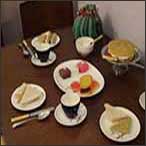How everyday meals have changed their names over time

Before the 1940s and 1950s in Britain, the names that ordinary people gave to everyday meals were different from today. These names were common across all families, although their weekday timings did differ from family to family to fit in with men leaving for and returning from work and children leaving for and returning from school. Timings were rigidly kept to and there was hardly any snacking or eating between meals.
____
By the webmaster based on personal experience from the 1940s onwards and discussions with people born earlier in the century
Dinner - not lunch
The word 'dinner' has changed its meaning over the years. In my childhood only in the upper class families was dinner an evening meal. For ordinary working-class people, dinner was what would now be called lunch in that it was eaten sometime between 1 and 2pm - sometimes a little earlier and sometimes a little later.
Dinner was the main meal of the day and it was expected to be fully cooked if either the man of the house or the children were at home at the time. If a man's work involved taking sandwiches for mid-day, some of the cooked food was kept back for him to eat when he came home, called supper. Many men, though, had their mid-day dinner in their works canteen - and in the first half of the 1940s, of course, they were away in the armed forces and fed there. Children either had cooked school dinners or went home for their cooked dinners.
Afters- not pudding or dessert
Ordinary families did not use names like dessert or sweet course for what came after the main meal. The word was 'afters'. Today, in the 21st century, the term does not flow easily off the tongue - but that was the way it was.
Tea - the meal
'Tea' was a meal, not a drink. (The drink was a 'cup of tea', a 'pot of tea' or a 'cuppa'.)
At weekends when the family was at home, tea was a light meal, often served as elegantly as austerity allowed: perhaps slices of bread and margarine or butter or maybe jam and if we were lucky perhaps a slice of cake. Nowadays we might call it 'afternoon tea'. Tea was provided around 4.00 and was followed later by a light and usually cold meal known as 'supper' or 'the evening meal'.
On weekdays tea and supper were combined, but still known as 'tea'. Nowadays we might call it 'high tea'. It was served sometime between 5.30 and 7.00. My mother always provided my tea as soon as I came home from school and then, once my father was demobbed from the forces, she did it again for him when he came in from work.
The weekday meal schedule for school children
In summary, for school children such as me, standard weekday meals were: breakfast at home, school milk during the mid-morning break, school dinner, tea at home and a hot drink at bedtime.
Why the name changes?
Although, as explained above,, I can tell you exactly how the names of meals changed, I don't know why. If you have any ideas, please contact me.
| sources | webmaster | contact |
Text and images are copyright
If you can add anything to this page or provide a photo, please contact me.



